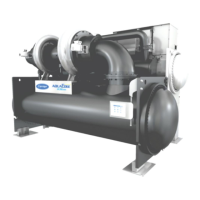74
• Water hardness: >0.5 mmol/l. Values between 1 and 2.5 mmol/l can be recommended. This will facilitate scale
deposit that can limit corrosion of copper. Values that are too high can cause piping blockage over time. A
carbonate hardness (TAC) below 100 is desirable.
• Dissolved oxygen: Any sudden change in water oxygenation conditions must be avoided. It is as detrimental to
deoxygenate the water by mixing it with inert gas as it is to over-oxygenate it by mixing it with pure oxygen. The
disturbance of the oxygenation conditions encourages destabilisation of copper hydroxides and enlargement of
particles.
• Specific resistance - electric conductivity: The higher the specific resistance, the slower the corrosion tendency.
Values above 30 Ohm·m are desirable. A neutral environment favours maximum specific resistance values. For
electric conductivity values in the order of 20-60 mS/m can be recommended.
• pH: Ideal case pH neutral at 20-25 °C 7 < pH < 8
If the water circuit must be emptied for longer than one month, the complete circuit must be placed under nitrogen
charge to avoid any risk of corrosion by differential aeration. Charging and removing heat exchange fluids should
be done with devices that must be included on the water circuit by the installer. Never use the unit heat
exchangers to add heat exchange fluid.
Piping systems must be properly vented, with no stress on waterbox pipes and covers. Use flexible connections to
reduce the transmission of vibrations. Water flows through the cooler and condenser must meet job requirements.
Measure the pressure drop across cooler and across condenser and compare this with the nominal values (see
selection document).
CAUTION: Water must be within design limits, clean, and treated to ensure proper chiller performance and to
reduce the potential of tube damage due to corrosion, scaling, or erosion. Carrier assumes no responsibility for
chiller damage resulting from untreated or improperly treated water.
5.1.10 - Check relief devices
Be sure that relief devices have been piped to the outdoors in compliance with standard EN 378-2. Piping
connections must allow for access to the valve mechanism for periodic inspection and leak testing. The standard
19DV relief valves are set to relieve at 500 kPa pressure.
5.2 Inspect wiring
WARNING: Do not check the voltage supply without proper equipment and precautions. Serious injury may result.
Follow power company recommendations.
CAUTION: Do not apply any kind of test voltage, even for a rotation check, if the chiller is under a dehydration
vacuum. Insulation breakdown and serious damage may result.
1. Examine the wiring for conformance to the job wiring diagrams and all applicable electrical codes.
2. Connect a voltmeter across the power wires to the VFD and measure the phase to phase and phase to
ground voltage. The voltage imbalance for these two measurements should be consistent. If not, confirm
the power supply to the chiller is a wye configuration with solidly grounded neutral. Compare this reading
to the voltage rating on the compressor and VFD nameplates.
3. Compare the ampere rating on the VFD enclosure nameplate to the rating on the compressor nameplate.
4. The VFD must be wired to components and terminals required for PIC5+ refrigeration control. Check line
side power and control components shown on the certified prints.
5. Ensure that fused disconnects or circuit breakers have been supplied to the VFD.
6. Ensure all electrical equipment and controls are properly grounded in accordance with the job drawings,
certified drawings, and all applicable electrical codes.
7. Ensure the customer’s contractor has verified proper operation of the pumps, cooling tower fans, and
associated auxiliary equipment. This includes ensuring motors are properly lubricated and have proper
electrical supply and proper rotation. The 19DV unit must maintain pump control through the IOBs/Carrier
Control Panel for freeze prevention algorithm.
8. Verify tightness of all wiring connections on the high and low voltage terminal blocks in the VFD
enclosure.
9. Inspect the control panels and VFD enclosure to ensure that the contractor has used the knockouts or
provided top hat to feed the wires into the enclosures. Generally, wiring into the top of the enclosures can
allow debris to fall into the enclosures. Clean and inspect the interior of the power panel and VFD

